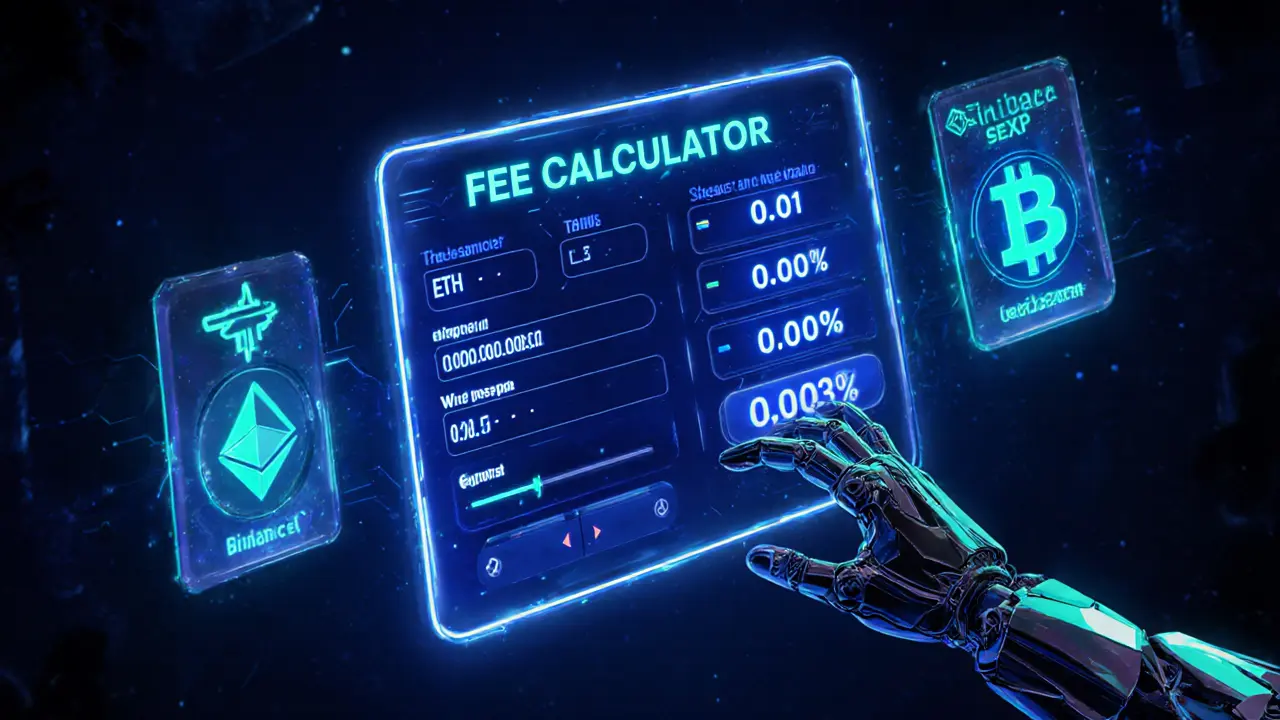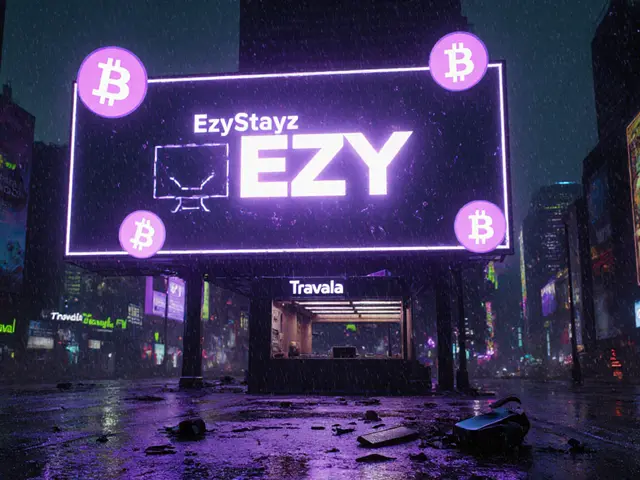Ethfinex Fee Calculator
Fee Structure
- Maker Fee (Limit Orders) 0.10%
- Taker Fee (Market Orders) 0.20%
- ETH Withdrawal Fee 0.01 ETH
Current ETH Price
Enter the current price of Ethereum to estimate withdrawal costs.
Estimate Your Trading Costs
Estimated Cost Breakdown
Comparison Summary
Compared to Binance and Coinbase, Ethfinex offers:
- Lower maker fees (0.10%)
- Clear, non-tiered fee structure
- Higher withdrawal fees (0.01 ETH vs 0.005 ETH on Binance)
- No credit card deposits
If you’ve been hunting for a crypto platform that promises low fees without sacrificing security, you’ve probably come across Ethfinex a cryptocurrency exchange that markets itself as secure, transparent, and liquid. In this review we break down the most common questions: How cheap are the fees? Is the platform really safe? What do real users think? And how does it stack up against the big players?
TL;DR - Quick Takeaways
- Maker‑taker fees: 0.10% maker, 0.20% taker - below the industry average.
- Withdrawal fee for Ethereum: 0.01ETH, which is higher than many rivals.
- Funding options: wire transfers only; no credit‑card deposits.
- User rating: 4.6/5 on Trustpilot (32 reviews) and 4/5 on Cryptogeek (1 review).
- Best for: traders who value lower fees and are comfortable with bank transfers.
Fee Structure - What You’ll Actually Pay
Ethfinex follows the classic maker‑taker model. Makers place limit orders that add depth to the order book and enjoy a 0.10% fee. Takers-those who hit existing orders-pay 0.20% per trade. For comparison, the typical market taker fee hovers around 0.25%, so Ethfinex saves you about 0.05% on each taker trade.
Because the fee schedule is tier‑free (no volume‑based discounts), you know exactly what you’re paying no matter how much you trade. This transparency can be a relief if you’ve been surprised by hidden‑fee clauses on other platforms.
Deposits & Withdrawals - Getting Money In and Out
Funding an Ethfinex account is limited to wire transfers. The platform does not accept credit‑card deposits, which is a drawback for casual traders who rely on instant card top‑ups. Wire transfers usually take 1‑3 business days, so you need to plan ahead.
When you want to pull funds out, the exchange charges a flat 0.01ETH withdrawal fee. At today’s price of roughly $1,950 per ETH, that translates to about $19.50 per withdrawal-higher than Binance’s $0.005ETH fee and Coinbase’s variable fee that often stays under $5 for similar amounts.
Security, Transparency, and Liquidity - The Core Pillars
Ethfinex emphasizes three value pillars:
- Security: The exchange claims cold‑storage of the majority of assets and two‑factor authentication for all logins. No public breach reports have surfaced as of October2025.
- Transparency: Fee schedules are displayed front‑and‑center, and trading volume data is published daily. However, details about regulatory licensing, insurance, or the team behind the platform remain sparse.
- Liquidity: By offering lower maker fees, Ethfinex encourages users to place limit orders, which deepens the order book and reduces slippage on larger trades.

User Sentiment - What Real Traders Say
On Trustpilot, Ethfinex holds a 4.6‑out‑of‑5 rating based on 32 reviews, with the latest feedback posted on September19,2025. Users frequently praise the intuitive UI and the low taker fee.
Cryptogeek shows a 4‑out‑of‑5 rating, but that figure stems from a single review. While the scores are encouraging, the small sample size suggests the platform still has a limited user base compared with giants like Binance or Coinbase.
When stacked against FTX US (rating 3/5 on Cryptogeek) and ionomy (rating 3/5 on Cryptogeek), Ethfinex comes out ahead in user satisfaction-but again, all those ratings are based on fewer than five reviews each.
Competitive Comparison - Ethfinex vs. The Big Names
| Metric | Ethfinex | Binance | Coinbase |
|---|---|---|---|
| Maker Fee | 0.10% | 0.00%-0.10% (tiered) | 0.00%-0.03% (tiered) |
| Taker Fee | 0.20% | 0.10% (standard) | 0.04%-0.30% (tiered) |
| ETH Withdrawal | 0.01ETH | 0.005ETH | Variable (~0.003ETH) |
| Funding Methods | Wire transfer only | Bank, credit card, PayPal, crypto | Bank, credit card, crypto |
| User Rating (Trustpilot) | 4.6/5 (32 rev.) | 4.3/5 (12k rev.) | 4.5/5 (9k rev.) |
What this tells us is that Ethfinex wins on simplicity and fee clarity, but it lags behind on funding flexibility and ETH withdrawal cost. If you don’t need instant deposits and you trade larger volumes where the 0.20% taker fee matters, Ethfinex can be a compelling niche choice.
Pros & Cons - Quick Decision Guide
- Pros:
- Below‑average taker fee (0.20%).
- Low maker fee encourages tighter spreads.
- Clear, upfront fee schedule.
- Strong user rating on Trustpilot.
- Cons:
- No credit‑card deposits - slower onboarding.
- Higher ETH withdrawal fee (0.01ETH).
- Limited public information on compliance, insurance, and team.
- Small review sample size - less community insight.
Bottom Line - Who Should Consider Ethfinex?
Ethfinex shines for traders who prioritize cost‑effective taker fees and are comfortable funding their account via bank wire. If you’re a serious market‑maker looking for deeper order books, the 0.10% maker fee is attractive. However, casual investors who want instant credit‑card top‑ups or who are extremely fee‑sensitive on withdrawals might gravitate toward Binance or Coinbase instead.
In short, Ethfinex fills a middle‑ground niche: lower fees than many legacy exchanges, but not the ultra‑wide ecosystem of the top three. Keep an eye on future updates-especially any move to add card deposits or lower the ETH withdrawal charge-and you’ll have a clearer picture of its long‑term viability.
Frequently Asked Questions
What are the exact fee percentages on Ethfinex?
Ethfinex charges 0.10% for makers (limit orders) and 0.20% for takers (market orders). There are no volume‑based tiers.
Can I fund my Ethfinex account with a credit card?
No. The platform only accepts wire transfers, which can take 1‑3 business days to clear.
Is Ethfinex regulated?
Public information about specific regulatory licenses or insurance coverage is limited. Users should perform due diligence before committing large sums.
How does the ETH withdrawal fee compare to rivals?
Ethfinex charges a flat 0.01ETH per withdrawal, which is higher than Binance (0.005ETH) and Coinbase (around 0.003ETH). The fee translates to roughly $20 at current prices.
What do users say about Ethfinex on Trustpilot?
The exchange holds a 4.6/5 rating from 32 reviews. Reviewers often mention fast order execution, low fees, and helpful support, while some note the lack of credit‑card deposits.






Comments
23 Comments
Alie Thompson
It is frankly disheartening to witness yet another exchange touting so‑called "low fees" while conveniently ignoring the broader ethical implications of their business model. When a platform such as Ethfinex charges a maker fee of 0.10% and a taker fee of 0.20%, one must ask: who truly benefits from these numbers? Certainly not the everyday trader who is already navigating an increasingly volatile market. Moreover, the withdrawal fee of 0.01 ETH translates into a substantial amount when ETH prices surge, effectively penalising users who need to move their assets quickly. The lack of tiered discounts also betrays a disregard for loyalty, suggesting that the exchange values short‑term profit over community building. It is unethical to conceal the fact that higher withdrawal costs can erode any potential savings from lower trading fees, especially for newcomers who are still learning the ropes. Additionally, the absence of fiat on‑ramps forces users into risky peer‑to‑peer arrangements, exposing them to fraud and regulatory gray zones. Let us not forget the security considerations; the platform’s documentation provides little reassurance about cold‑storage practices, leading to legitimate concerns about custodial risk. The broader crypto ecosystem is built on principles of decentralisation and user empowerment, yet Ethfinex seems to operate with a centrally‑controlled mindset that runs counter to these ideals. In the end, a so‑called "lower fee" structure is merely a veneer that masks deeper systemic issues, and traders would do well to scrutinise the complete picture before depositing any capital.
Samuel Wilson
From a structural perspective, Ethfinex presents a clear fee schedule: 0.10% for makers and 0.20% for takers. This simplicity can be advantageous for users who prefer transparency over tier‑based models. The withdrawal fee of 0.01 ETH is comparatively higher than some competitors, yet it remains straightforward without hidden costs. It is also worth noting that the exchange does not support credit‑card deposits, which may limit accessibility for newcomers but reduces the risk of chargeback fraud. Security‑wise, Ethfinex states that they employ industry‑standard encryption and cold storage for the majority of assets, though detailed audits are not publicly available. Overall, for traders who value a flat‑rate fee structure and are comfortable managing their own fiat off‑ramps, Ethfinex could be a viable option, provided they perform their own due‑diligence on the platform’s custodial practices.
Rae Harris
Yo, real talk – Ethfinex is kinda the wildcard in the fee game. Maker’s only 0.10%? That’s sweet for LPs, but the taker’s 0.20% can bite you when you’re just trying to flip that alt. And that 0.01 ETH withdrawal? If ETH’s at $4k, you’re coughing up $40 just to get out. It’s like they’re rewarding the high‑frequency bots while punishing the regular hustlers. Plus, no credit‑card deposits means you gotta hop through a fiat bridge yourself – more steps, more friction. Security? They say they’ve got cold storage, but where’s the public audit? In the DeFi space, that’s a red flag. Bottom line: if you’re a market‑maker you’ll love the flat rates, but if you’re a retail whale you might want to look elsewhere.
Danny Locher
Sounds like Ethfinex is decent if you don’t need to deposit fiat directly. The fees aren’t terrible and the UI seems clean. I’d keep an eye on the withdrawal costs though – they can add up.
Shanthan Jogavajjala
Just a heads‑up: the fee calculator on the site is a bit clunky. When you input the ETH price, it sometimes rounds down, which skews the withdrawal estimate. Also, the API documentation misses some endpoint parameters, making it harder to integrate bots. If you rely on precise data for arbitrage, you might want to double‑check the numbers manually.
Adetoyese Oluyomi-Deji Olugunna
i think i must say tht ethfinex is realy a funtitonal platform,but the fee strcucture could be imrpoved. the 0.01 eth wthdrawl is a bit hiig for new traders. also, i appreciate the clear layout, but some text have typo like "fee completioon" indusrsing confusion.
Krithika Natarajan
Regarding the comment about the calculator, I’ve noticed the same rounding quirks. A quick manual check can help ensure accuracy.
Cindy Hernandez
Ethfinex strikes a balance between simplicity and cost. The flat‑fee model is easy to understand, which is helpful for newcomers who might be overwhelmed by tiered structures. However, the higher withdrawal fee means you should plan your exits carefully, perhaps consolidating withdrawals to minimize the impact. Security is decent, though the lack of publicly‑available audits suggests a bit of caution. Overall, it’s a solid middle‑ground option if you’re comfortable handling fiat off‑ramps yourself.
Donald Barrett
Totally overhyped, just a fee trap.
Christina Norberto
It would be remiss of any analyst to overlook the inherent systemic vulnerabilities embedded within the architecture of Ethfinex. While the publicized fee schedule appears modest at first glance-0.10% for makers, 0.20% for takers-the reality is that these percentages are but a veneer masking the deeper financial asymmetries that privilege high‑frequency traders and institutional actors. Moreover, the withdrawal levy of 0.01 ETH, when contextualised against the current market capitalisation of Ethereum, translates into a prohibitive barrier for retail participants seeking liquidity. The platform’s eschewal of credit‑card deposits ostensibly mitigates chargeback fraud but simultaneously imposes an additional layer of friction that can be exploited by nefarious actors engaged in fiat‑to‑crypto laundering schemes. Security assertions are made without the substantiation of third‑party audits; this opacity is antithetical to the ethos of decentralisation that underpins the broader crypto movement. In sum, while the superficial metrics may suggest a competitive offering, a rigorous due‑diligence process reveals that Ethfinex’s purported advantages are considerably overstated and warrant circumspect engagement.
Karl Livingston
I hear the concerns loud and clear, and I’d add that the community’s experience often reflects these systemic quirks. Users have reported occasional latency spikes during peak market hours, which can exacerbate the impact of the taker fee when rapid execution is essential. On a brighter note, the platform’s UI is intuitive, and the support team responds relatively quickly to tickets, which helps mitigate some of the anxiety around security uncertainties. If you’re willing to accept the higher withdrawal cost as a trade‑off for a straightforward fee structure, Ethfinex can serve as a functional venue, especially for those who already possess an external fiat gateway.
Emily Pelton
Ethfinex, with its flat‑rate fee architecture, offers a refreshing alternative to the labyrinthine tiered models that dominate the crypto exchange landscape; however, one must consider the holistic cost of ownership, which includes not only the nominal 0.10% maker and 0.20% taker fees but also the relatively steep 0.01 ETH withdrawal levy, a figure that can erode profitability, particularly during periods of elevated ETH valuation, and while the absence of credit‑card deposits may appear restrictive at first glance, it simultaneously reduces exposure to chargeback fraud, thereby enhancing the platform's overall security posture; nevertheless, the lack of publicly disclosed third‑party security audits introduces an element of opacity that prudent traders should factor into their risk assessments, and for users adept at managing off‑ramp fiat conversions, the platform's streamlined interface and responsive support team can mitigate many of the operational frictions inherent to decentralized finance, making Ethfinex a viable, though not unassailable, component of a diversified trading strategy.
sandi khardani
When you really dig into the economics of Ethfinex, a few nuanced dynamics emerge that many casual observers tend to overlook, and these intricacies can significantly influence a trader's bottom line over time; firstly, the flat‑fee structure, while admirable for its transparency, does not account for volume‑based discounts that reward high‑frequency market makers, thereby subtly incentivising a narrower cohort of participants who can sustain the cost of the 0.01 ETH withdrawal fee through frequent trading activity; secondly, the platform's decision to eschew fiat on‑ramps, while seemingly a security‑centric move to reduce exposure to traditional banking risks, actually imposes an additional operational burden on users who must navigate external fiat gateways, a process that can introduce latency and potential price slippage during volatile market conditions, ultimately affecting trade execution quality; thirdly, the security architecture, although ostensibly robust with industry‑standard encryption and a cold‑storage regime, suffers from a lack of third‑party audit transparency, which could be a red flag for risk‑averse investors seeking verifiable resilience against hacks; finally, the user experience, while clean, occasionally suffers from intermittent UI lag during peak periods, which, in conjunction with the aforementioned fee considerations, paints a picture of a platform that excels in simplicity but may fall short for those seeking comprehensive, volume‑driven cost efficiencies and absolute assurance of custodial safety.
Fiona Chow
Wow, another brilliant example of crypto hype-so many “features” but really just a fancy fee trap.
Rebecca Stowe
Even with its quirks, Ethfinex can still be a decent option for those who plan their trades wisely and keep an eye on withdrawal costs.
Mark Briggs
Sure, if you like paying extra for nothing.
mannu kumar rajpoot
The platform’s opacity is no coincidence; hidden layers often mask deeper control mechanisms that align with larger, possibly covert, financial interests.
Hardik Kanzariya
It’s easy to get caught up in conspiracies, but from a practical standpoint, the main thing is to ensure you have a reliable fiat gateway and to monitor the withdrawal fees closely. If those boxes are checked, Ethfinex can serve its purpose without too many surprises.
Millsaps Delaine
One must approach Ethfinex with a discerning eye, for while the advertised fee structure appears modest, the hidden costs embedded within the platform’s operational framework can be substantial; for instance, the 0.01 ETH withdrawal fee, when contextualised against fluctuating market valuations, may silently erode a trader’s profitability, especially for those who transact in smaller volumes and rely on frequent withdrawals to manage liquidity; furthermore, the absence of credit‑card deposits, often touted as a security feature, nevertheless places an additional logistical burden on users who must orchestrate external fiat conversions, a process that can introduce latency and potential exposure to unfavorable exchange rates; additionally, the platform’s security posture, while ostensibly robust, lacks publicly disclosed third‑party audits, thereby fostering an environment of uncertainty that prudent investors cannot afford to overlook; ultimately, while Ethfinex may present a veneer of simplicity, the underlying complexities demand rigorous scrutiny before allocating capital.
Jack Fans
Ethfinex’s interface is clean, the support team is responsive, and the fee schedule is transparent; however, the higher withdrawal cost and lack of public audit reports suggest that users should approach the platform with measured caution.
Irene Tien MD MSc
Let’s be crystal clear: the rhetoric surrounding Ethfinex’s “low fees” is a cleverly crafted mirage designed to lure unsuspecting retail traders into a system riddled with hidden extraction mechanisms; the 0.01 ETH withdrawal levy, while superficially presented as a modest fixed charge, translates into a formidable financial drain whenever Ethereum’s market price spikes, effectively siphoning funds from the very users the platform claims to serve; combine that with the conspicuous absence of a fiat‑on‑ramp, and you have a recipe for forced reliance on off‑platform corridors that are, at best, opaque and, at worst, ripe for malicious exploitation, all while the exchange touts its “transparent fee structure” as a badge of virtue; in the grand scheme, without verifiable third‑party security audits, the promised safety is nothing more than a speculative promise, leaving users perpetually vulnerable to the unseen machinations that underlie many so‑called decentralized financial services.
Robert Eliason
Yo, maybe the fees aren’t that bad if you just ignore the hype, but who actually does that? 🤔
Cody Harrington
Thanks for the thorough breakdown. I’ll keep these points in mind when I decide whether to use Ethfinex.
Write a comment